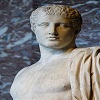Atlas
Titan god of endurance
In Greek mythology the Titan Atlas was responsible for bearing the weight of the heavens on his shoulders, a burden given to him as punishment by Zeus. Father of many stars and a protagonist in one of Hercules' famous labours, this giant of a god gave his name to a huge mountain range in northern Africa, the great Atlantic Ocean and any large collection of maps.
With a name perhaps conveying the meaning 'very enduring', Atlas was the son of the Titans Iapetus and Clymene (or Themis) and the brother of Epimetheus, Menoetius and Prometheus. Atlas was the father of the nymph Calypso and another daughter was Maia, who was one of the Pleiades and mother of the messenger god Hermes.
Atlas Punishment from Zeus
Atlas was given the task of holding the heavens on his shoulders as punishment from Zeus for leading the Titans in their battle with the Olympian Gods for control of the heavens. In similar vein, Homer describes Atlas in his Odyssey as ‘deadly-minded’ and as holding the pillars which hold the heavens and earth apart. Hesiod in his Theogony also describes Atlas as holding up the heavens and locates him in the land of the Hesperides (female deities famed for their singing), which was far to the west, at the edge of the world. Later tradition, including Herodotus, associates the god with the Atlas Mountains where the Titan was transformed from a shepherd into a huge rock mountain by Perseus using the head of the Gorgon Medusa with her deadly stare.
Other associations with Atlas are as the father of many constellations such as the seven stars named after the Pleiades, as a source of great wisdom and founder of astronomy, and, by Plato in his Critias, as the original king of Atlantis. Perhaps the most famous myth involving Atlas though is his role in one of the celebrated twelve labours of Hercules. The hero was required by Eurystheus to fetch the golden apples from the fabled gardens of the Hesperides which were sacred to Hera and guarded by the fearsome hundred-headed dragon Ladon.
Following the advice of Prometheus, Hercules asked Atlas (in some versions the father of the Hesperides) to get him the apples while he, with the help of Athena, took the world onto his shoulders for a while, giving the Titan a welcome respite. Perhaps understandably, when returning with the golden apples, Atlas was reluctant to reassume the burden of carrying the world. However, the wily Hercules tricked the god into swapping places temporarily while the hero got himself some cushions to more easily bear the tremendous weight. Of course, as soon as Atlas was back holding the heavens, Hercules with his golden booty, hot-footed back to Mycenae.
Representations in Art
In Greek art, Atlas is, from the 6th century BCE, often featured in depictions of the labours of Hercules, most notably in a metope from the temple of Zeus at Olympia (c. 460 BCE) where he stands in the gardens of the Hesperides. Similar scenes were also popular on Greek pottery decoration, particularly with his brother Prometheus. In Hellenistic and Roman times Atlas is frequently represented in his now familiar position with bent knees and back, straining to hold the globe on his shoulders. Perhaps the most outstanding example of this pose is the 2nd century CE sculpture now in the Archaeological Museum of Naples.
[1]
Descendants of Atlas
But before the punishment, Atlas was in love with Pleione, one of the oceanids, the daughters of Oceanus and Tethys who gave birth to Pleiades, seven in numbers, that were mentioned by most authors. Their names were Alcyone, Asterope, Celaeno, Electra, Maia, Merope and Teygate. There is a further explanation presented by Hyginus who mentiones in his Fabulae that Atlas and Pleione actually had twelve daughters and a son Hyas. Five of them were Hyades that were named after their brother who was killed by lion and they grieved for him so much that they died because of it and were placed among stars. Their names were Ambrosia, Coronis, Eudora, Phaesyla, Polyxo. And when the Hyades died, the rest of the sisters also brought death to themselves by further grief and were placed among stars known as Pleiades.
According to Diodorus Siculus, Atlas also had a brother Hesperus and eventually married one of his daughters by the name of Hesperis. She bore him seven daughters that were named Atlantides after their father and Hesperides after their mother. They were very beautiful and pure and therefore they caught the eye of Egyptian king who dispatched pirates to kidnap them. They were later saved by Heracles.
"Released" from his burden
According to Fulgentis` Mythologies and Ovid`s Metamorphoses, Atlas, with the heavens on his back, was at some point encountered by Perseus who was on his way back to Seriphos Island. Perseus kindly asked the titan for shelter over night, telling him that he was a son of Zeus. The titan replied by stating that he was a liar which angered the hero. Perseus then in revenge turned Atlas into stone by showing him the head of Medusa and released him from his burden. From that point on, he was known as Mount Atlas.
Now, this contradicts the story of Atlas meeting Heracles, becuase Perseus lived in the times before Heracles and therefore Heracles could not meet Atlas and ask him for help, if he was already turned into mountain.
[2]












